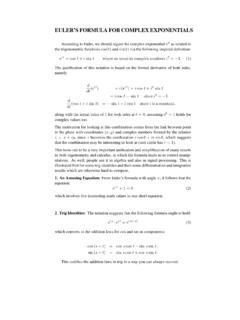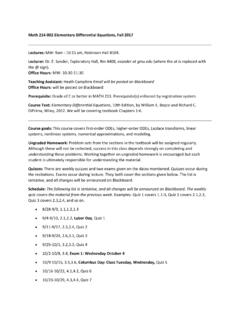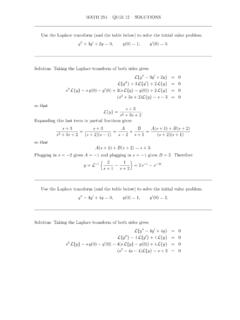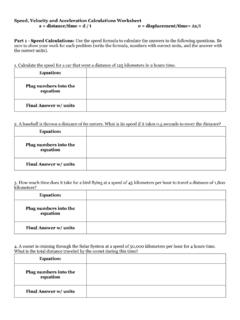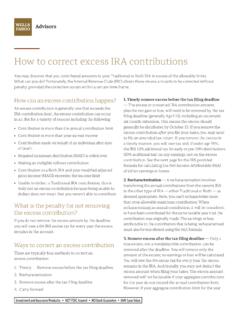Transcription of EULER’S FORMULA FOR COMPLEX EXPONENTIALS
1 EULER S FORMULA FOR COMPLEX EXPONENTIALSA ccording to Euler, we should regard the COMPLEX exponentialeitas related tothe trigonometric functionscos(t)andsin(t)via the following inspired definition:ei t= cost+isintwhere as usual in COMPLEX numbersi2= 1.(1)The justification of this notation is based on the formal derivative of both sides,namelyddt(ei t)=i(ei t) =icost+i2sint=icost sintsincei2= 1ddt(cost+isint) = sint+icostsinceiis a with the initial value of 1 for both sides att= 0, assuminge0= 1holds forcomplex values motivation for looking at this combination comes from the link between pointin the plane with coordinates(x, y)and COMPLEX numbers formed by the relationz=x+iy, sincezbecomes the combinationrcos +irsin , which suggeststhat the combination may be interesting to look at (unit circle hasr= 1).
2 This turns out to be a very important unification and simplification of many resultsin both trigonometry and calculus, in which the FORMULA leads us to correct manip-ulations. As well, people use it in algebra and also in signal processing. This isillustrated first for some trig identities and then some differentiation and integrationresults which are otherwise hard to An Amusing Equation:From Euler s FORMULA with angle , it follows that theequation:ei + 1 = 0(2)which involves five interesting math values in one short Trig Identities:The notation suggests that the following FORMULA ought to hold:ei s ei t= ei(s+t)(3)which converts to the addition laws for cos and sin in components.
3 Cos (s+t) = cosscost sinssint,sin (s+t) = sinscost+ codifies the addition laws in trig in a way you can always can also express the trig functions in terms of the COMPLEX exponentialsei t,e i tsince we know that cos(t) is even in t and sin(t) is odd in t. This reads as follows:ei t= cost+isint,e i t= cost isint(4)so adding (and dividing by 2) or subtracting (and dividing by 2 i) gives:cost=ei t+ e i t2,sint=ei t e i t2i.(5)Another manipulation suggested by the notation:ei te i t= ei t i t= e0= 1(6)which leads to1 = (cost+isint) (cos ( t) +isin ( t)) = (cost+isint) (cost isint)= cos2t i2sin2t= cos2t+ are many other uses and examples of this beautiful and useful FORMULA .
4 As afurther example note that lots of identities can be derived. The following is knownas DeMoivre s Theorem:For any positive integern,ei n t= (ei t)n= (cost+isint)n.(7)This allows us to find solutions to algebra equations likez3= 1by viewing1via Euler as having angle0,2 ,4 . Then the three solutions are found to be1,e2 i3= 1 + 3i2,e4 i3= 1 3i2(8)Note that you could find the solutions by factoring, fromz3 1 = (z 1)(z2+z+ 1),(9)but factoring won t be easy forz7 1, while Euler s FORMULA works : Signal ProcessingUsing the solutions tozn= 1which formnequally spaced points around the circle, approximations for periodic functions (sig-nals) are found using the finite Fourier transform.
5 For powers of 2 (and other com-posite numbers), a fast algorithm exists to compute these (fast FT).3. Calculus:The functions of the formea tcosbtandea tsinbtcome up inapplications often. To find their derivatives, we can either use the product rule oruse Euler s FORMULA (ddt)(ea tcosbt+iea tsinbt) = (ddt)e(a+ib)t= (a+ib)e(a+ib)t= (a+ib)(ea tcosbt+iea tsinbt)= (aea tcosbt bea tsinbt)+i(bea tcosbt+aea tsinbt).This finds both derivatives simultaneously and is especially nice for higher deriva-tives (try the second derivatives yourself both ways!).Integration:Even better is the integral aspect: To integrateea tcosbtandea tsinbtsimultaneously,integrate the COMPLEX exponential instead!
6 (ea tcosbt+iea tsinbt)dt= e(a+ib)tdt=1a+ibe(a+ib)t+C=a i ba2+b2(ea tcosbt+iea tsinbt) +C=aa2+b2ea tcosbt+ba2+b2ea tsinbt) +C1+i( ba2+b2ea tcosbt+aa2+b2ea tsinbt+C2).Another integration result is that any product of positive powers of cosine and sinecan be integrated explicitly. From Euler s FORMULA this becomes an algebra problemwith an easy calculus part, as illustrated in the following example: cos2t dt= (ei t+ e i t2)2dt= (e2i t+ 2 + e 2i t4)dt(10)which can be done is clearly nothing special about the power 2 or cosine alone, so any positivepower of sine and cosine can be expanded and then COMPLEX logarithmUsing polar coordinates and Euler s FORMULA allows us todefine the COMPLEX exponential asex+i y= exei y(11)which can be reversed for any non-zero COMPLEX number written in polar form as ei by inspection:x= ln( ), y= to which we can also add any integermultiplying2 toyfor another solution!
7 4. Differential equations:This FORMULA really comes into its own when we needto solve differential equations with constant coefficients. Then the goal is to findthe right numbersa, bso that the above functions which we just differentiated solvea given equation. For example, electrical circuits lead to differential equations thatrelate current, charge and voltage based on the circuit elements. Circuit elementsare described by certain parameters like inductance, resistance, and become coefficients in the differential differential equationa y +b y +c y= 0can be solved by seekingexponential solutions with an unknown exponential factor. Substitutingy= er tinto the equation gives a solution if the quadratic equationa r2+b r+c= lots of values ofa, b, c, namely those whereb2 4a c <0, the solutions arecomplex.
8 Euler s FORMULA allows us to interpret that easy algebra Problems Involving Euler s Formula1. Consider the equationz6 1 = 0. Solve it in the two ways described below andthen write a brief paragraph conveying your thoughts on each and your Euler s formulaB. Viewz6 1as a difference of squares, factor it that way, then factor eachfactor again. This identifies two quadratics that you can use to find the four rootsbesides 1 and -1. (Fun bonus: factor as difference of cubes originally and you geta degree four polynomial with those four roots as a product of quadratics)2. Use Euler s FORMULA to find the two COMPLEX square roots of i by writing i as acomplex exponential.
9 Do it also for iand check that i= 1 A crazy notion: findiiby writing i as a COMPLEX (Challenging) Factoringz2+ 1 = (z+i)(z i)and using partial fractions,integrate (formally) 1z2+ 1dzand try to get back to the arctan you know and love by using the COMPLEX log.
